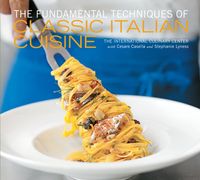Advertisement
Harvesting and Processing
Appears in
Primal and Subprimal Cuts, and Cooking Technique
During the butchering process in the United States, beef and other livestock meats are separated into primal and subprimal cuts (tagli). Primal cuts are those initially made as the meat is separated from the carcass. (See for diagrams of beef and veal.) Primal cuts may be sold or cooked complete, or further broken down into subprimal cuts.
Each cut corresponds to a different region or muscle group on the animal’s body. Each region is composed of meat of variable tenderness, depending on how much work the muscles in that part of the body do. For example, leg and neck muscles do the most work in an animal’s everyday life from walking, eating, and so forth; therefore, these muscles are likely to be fibrous and less tender than those along the animal’s breast-plate. As a general rule of thumb, meat becomes more tender as distance from “hoof and horn” increases.

